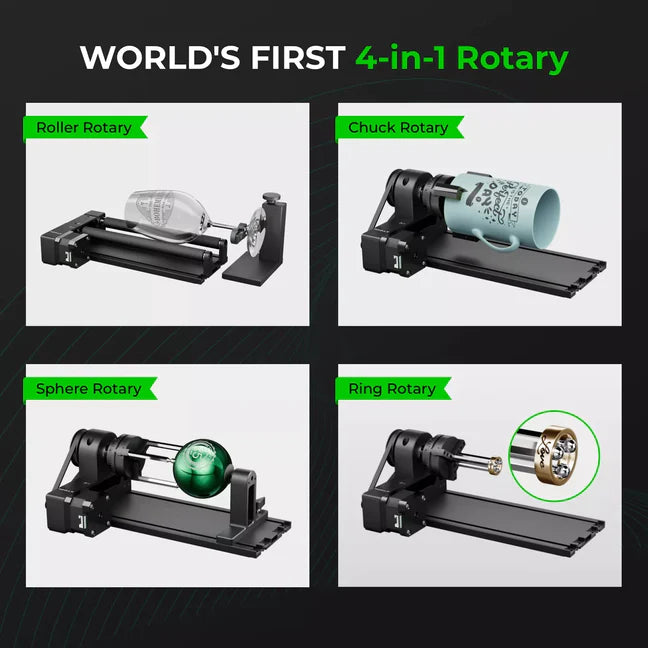Desktop laser engravers are quite popular among hobbyists and small businesses. Most of these laser engravers work wonderfully right out of the box, fulfilling basic engraving needs with precision.
But, what if I told you there’s more to your laser engraver than meets the eye? A world of add-ons that enhance performance and expand possibilities. This article lists 9 must-have accessories for your laser engraver. They are not just nice to have; they are game-changers.
1. Rotary Attachment
A laser engraver’s standard base works well for flat surfaces. But for cylindrical objects like tumblers and hydro flasks, a rotary attachment is necessary. It holds and rotates the object under the laser head for engraving around the circumference.

Some rotary attachments offer more than just the engraving of cylindrical objects. For instance, xTool RA2 Pro, is the first of its kind, with 4 features packed in one.
For cylindrical engravings, it turns into a ‘chuck rotary’, which holds the mug or tumbler and rotates. For irregular cylinder objects, like glass, it can be transformed into a ‘roller rotary’. There’s a ‘sphere rotary’ for pure spherical objects like balls and a ‘ring rotary’ for internally hollow rings. The attachment has padded jaws for a strong grip and to protect fragile items. It’s also adjustable in height and diameter.
2. Focus Lenses
Focus lenses are essential for laser engravers, especially for cutting materials of different thicknesses. These lenses converge the laser beam to create a focal point, where the laser cuts or engraves the material.
Common focus lenses come in focal lengths of 1.5, 2.0, 3.0, and 4.0 inches. Lenses with smaller focal lengths, like 1.5 inches, provide higher resolution for detailed engraving. However, they have a limited depth of focus. In contrast, lenses with larger focal lengths, such as 4.0 inches, can cut deeper but may not be as precise for fine engraving.
xTool lenses are already optimized for thick cutting, but we do offer some protective/replacement lenses for machines, in case your original lens gets damaged.
3. Air Assist
During laser engraving, the material is burned, which leads to the production of smoke, fumes, and other residue particles. An air assist set addresses this issue by providing a focused stream of compressed air. The stream is directed precisely at the area where the laser is working.
The air assist is particularly beneficial when laser engraving wood, a material prone to burn marks or charring. By clearing away smoke and particles, it reduces the likelihood of these marks. Additionally, air assist plays a vital role in keeping laser lenses clean.
4. Riser Base
Desktop laser engravers are compact, and usually fit in small-size objects. But, there are times when taller objects need to be engraved. This is where a riser base becomes useful. It elevates the machine, creating room for taller items or for setups involving rotary engraving.
Riser bases come in different forms. One type is a hollow base with solid sides, like the xTool M1 riser base, which provides a single, unified space for elevation. A similar case is the xTool P2 Riser Base, but it’s more advanced. It has a slot for an automated pass-through, a feature handy for long-sheet engravings.

Another type includes individual risers, such as the risers for xTool D1 Pro, which can be placed under the machine’s frame.

5. Honeycomb Panel
Usually, a plain base is placed on the bottom bed of the laser engraver. It may get burnt marks over time. The honeycomb panel, as the name suggests, has a unique structure that is designed to minimize the reflection of laser beams as they hit the surface. Additionally, the honeycomb design allows for efficient ventilation. This panel is mostly employed in conjunction with a riser base since it requires extra space.

6. Fume Exhaust Fan
Laser cutting and engraving result in smoke and fumes that need to be evacuated. If your working space has windows or access to outdoors, a fume exhaust fan is quite handy for smoke removal. It usually comes with a longer hose, so that you may easily vent out the smoke.
xTool inline duct fan is one great example. It evacuates smoke at 410 CFM, and the 2.4m long hose allows for efficient evacuation out of the window. Its noise is unnoticeable; works at just 34db.

7. Smoke Purifier
For those working in enclosed spaces without direct access to the outdoors, a smoke purifier is an excellent alternative to an exhaust fan. It is useful in situations where venting smoke and fumes directly outside isn't feasible.
A smoke purifier first sucks out all smoke and then cleans it through a multi-step filtration process before releasing it. For instance, the xTool smoke purifier cleans the smoke in 3-stage, filtering it up to 99.97%.

8. Enclosure
Most laser engravers have an enclosed design, which makes them quite safe for operation. However, some earlier models, xTool D1 Pro, are open lasers. For safely using them, an enclosure is recommended, especially if you are working.
The enclosure serves multiple purposes. Firstly, it acts as a barrier between the user and the laser rays. It confines the laser within the space, reducing the risk of accidental contact or direct exposure to the laser beam. Secondly, it helps in managing fumes and smoke generated during the engraving process. The enclosure often comes with a single vent, which can be coupled with an exhaust or smoke purifier for the safe removal of by-products.

9. Fire Safety Set
In laser engraving, where flammable materials like wood are burned, the risk of fire is a serious concern. A fire safety set becomes an essential accessory for added security.
A comprehensive fire safety set does more than just detect fire; it also alerts the user. Advanced systems, like the one offered by xTool, are equipped with 5-directional fire detection. Upon detecting fire, it not only sounds an alarm but also cuts off the power automatically to prevent further risk. What sets it apart is its fire-extinguishing capability. It releases a burst of CO2, which extinguishes the fire immediately.
Conclusion
A basic laser engraving machine may meet your initial needs, but to truly extend its functionality – especially for work on cylindrical, tall, or long objects – additional attachments are essential.
Some of these accessories not only enhance the machine’s capabilities but are also crucial for safety. By using one or more of these enhancements, you will notice a significant improvement in the laser engraver’s performance.




